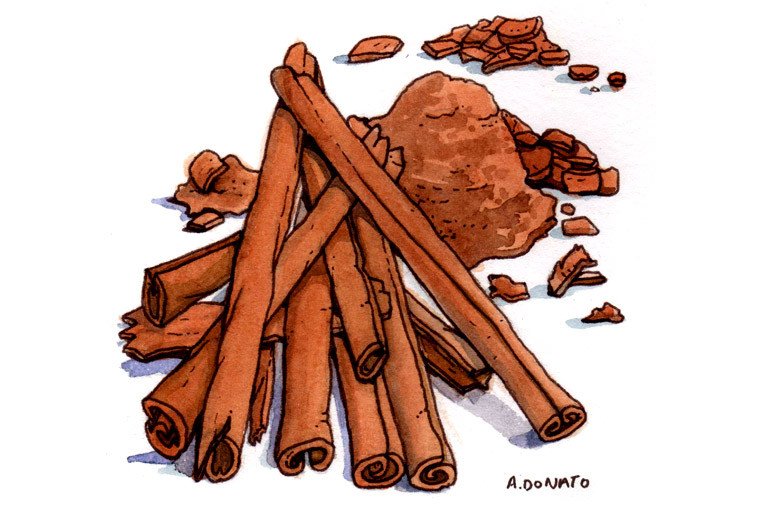
Common Names
- Cassia
For Patients & Caregivers
Tell your healthcare providers about any dietary supplements you’re taking, such as herbs, vitamins, minerals, and natural or home remedies. This will help them manage your care and keep you safe.
Evidence suggests possible benefits with cinnamon for lowering blood sugar and blood fat levels, but additional studies are needed to confirm this.
Cinnamon refers to several plants native to Southeast Asia. The bark, rich in essential oil, is used as a flavoring agent and as a spice. Cinnamon has a long history of use as an herbal medicine.
Lab studies suggest that cinnamon has antibacterial, anti-inflammatory, and antioxidant properties. Studies in humans suggest it may help lower blood sugar, total cholesterol and triglyceride levels, and reduce risks for cardiovascular disease, stroke and diabetes. However, additional studies are needed to confirm these effects.
- Diabetes
Results have been mixed for various diabetes-related markers. A few meta-analyses suggest improvements in blood sugar and blood fat levels, but larger well-designed trials are needed to confirm these effects. - Inflammation
Lab studies suggest that cinnamon can reduce inflammation, but human data are lacking. - Arthritis
Cinnamon is used in traditional medicine for arthritis, but there is no scientific evidence to support this claim.
- GI upset: stomachache, heartburn, nausea, constipation, diarrhea
- Allergic reactions
Case reports
- Mouth sores: Associated with using oral cinnamon products like herbal toothpaste and gum.
- Occupational allergy: With cinnamon due to exposure to its compounds.
- Skin irritations: In one case with use of vaginal suppositories containing cinnamon oil, and in another case after consuming herbal tea that had large amounts of cinnamon.
Patient Warnings:
- Some cinnamon products contain high levels of coumarin, a natural constituent, that can cause liver damage.
Do Not Take if:
- CYP450 2A6, 2C9, 2D, and 3A4 substrate drugs: Lab studies suggest cinnamon may increase the risk of side effects of these drugs. Clinical relevance has yet to be determined.
- Statins: When taken along with statins, cinnamon has been reported to cause hepatitis.
- Pioglitazone (an antidiabetic drug): Animal studies show that when used together, cinnamon can increase the bioavailability of pioglitzone.
For Healthcare Professionals
Cinnamon refers to several plants that belong to the genus Cinnamomum, native to Southeast Asia. The bark, rich in essential oil, is used as a flavoring agent and as a spice. Medicinal uses include appetite stimulation, and treatment of arthritis, inflammation, and dyspepsia. In traditional Chinese medicine, cinnamon is used along with other herbs in decoctions to treat colds.
In vitro studies suggest that cinnamon has antioxidant (1) (2), anti-inflammatory (3), immunomodulatory (4) (5), antimicrobial (6), antitumor (7) , and antiestrogenic (26) properties.
Studies in humans have also been conducted. In clinical trials of cinnamon for type 2 diabetes, results are conflicting (8) (9) (10) (11) (37) (46) (47). Various meta-analyses and a review suggest some improvements in glycemic control with cinnamon and its extracts (12) (36) (48), but studies had high heterogeneity and larger well-designed trials are needed. Other meta-analyses suggest cinnamon supplementation may reduce blood triglycerides, total cholesterol concentrations (38), and C-reactive protein levels (49), but again well-designed studies are needed to confirm these effects.
Other preliminary data suggest cinnamon extracts may decrease insulin resistance in women with polycystic ovary syndrome (39); improve parameters of metabolic syndrome (40); and reduce dental plaque and gingivitis (32). Studies involving topical use of a cinnamon ointment suggest it can relieve perineal pain and improve healing of episiotomy incisions in postpartum women (33).
In a safety study of patients with prediabetes, a water-soluble cinnamon extract did not appear to affect electrocardiographic measures (50). However, certain cinnamon products are high in coumarin (18) (17), which can cause hepatotoxicity (19) and interact with other prescription drugs (20).
Cinnamon bark
- Diabetes
- Inflammation
- Arthritis
Hydroxycinnamaldehyde, a compound present in cinnamon, exerts anti-inflammatory effects by inhibiting NO production via nuclear factor (NF)-kappaB (3). Cinnamon also inhibits hepatic HMG-CoA reductase activity (24) and reduces blood lipid levels in animals and humans (10). In another study, methylhydroxychalcone polymer isolated from cinnamon was shown to mimic insulin by activating the insulin receptors (23).
Cinnamon extract binds to estrogen-receptor beta and has a direct stimulatory effect on bone formation (25). The n-hexane extract of cinnamon has antiestrogenic activity (26). In other studies, increased proapoptotic activity with cinnamon extract was attributed to NF-kappaB and AP1 inhibition (7), while antiangiogenic effects occurred via VEGF inhibition (22).
Most common: Gastrointestinal upset and allergic reactions that are self-limiting in many cases (42).
Case reports
- Plasma cell gingivitis and stomatitis: Following use of oral cinnamon products including toothpaste and chewing gum (13) (15) (16) (27) (34).
- Occupational allergy: In a baker due to exposure to cinnamal, a compound in cinnamon (28).
- Allergic contact dermatits: In an 18-year-old following use of vaginal suppositories containing cinnamon oil (29).
- Systemic dermatitis: In a 26-year old after drinking several cups of herbal tea containing large amounts of cinnamon (41).
- CYP450 substrates: Preclinical studies suggest cinnamon inhibits CYP 2C9, 3A4 (31), 2A6 (43), and 2D (44), and may interfere with the actions of drugs metabolized by these enzymes (31). Clinical relevance has yet to be determined.
- Statins: When taken along with statins, cinnamon has been reported to cause hepatitis (35).
- Pioglitazone: Cinnamon enhanced bioavailability upon concomitant use in preclinical studies (45).